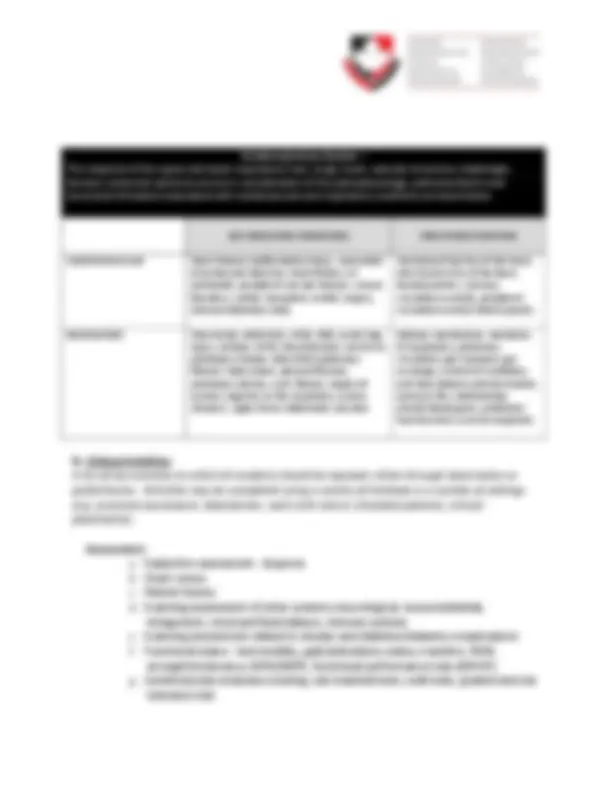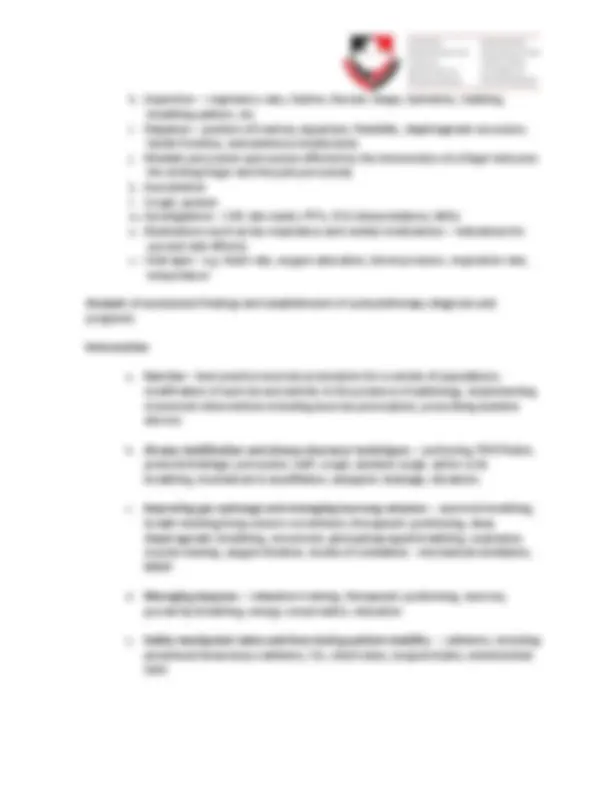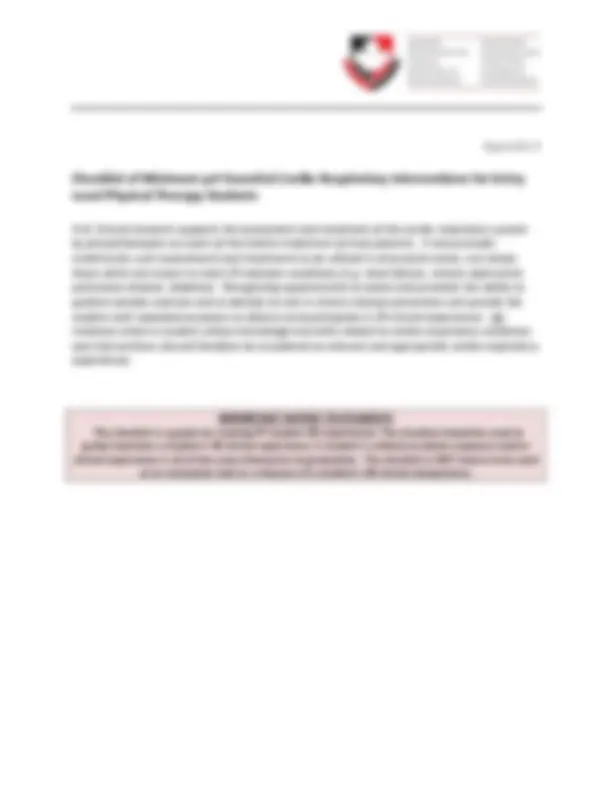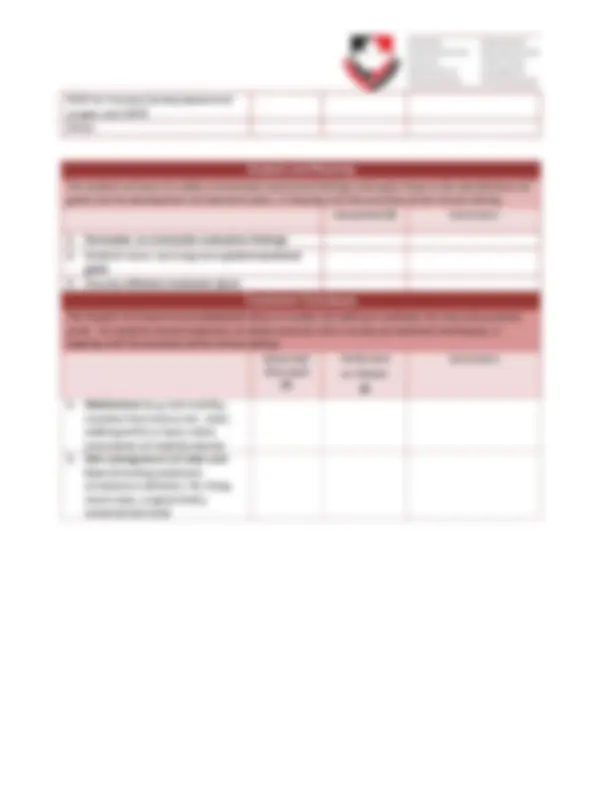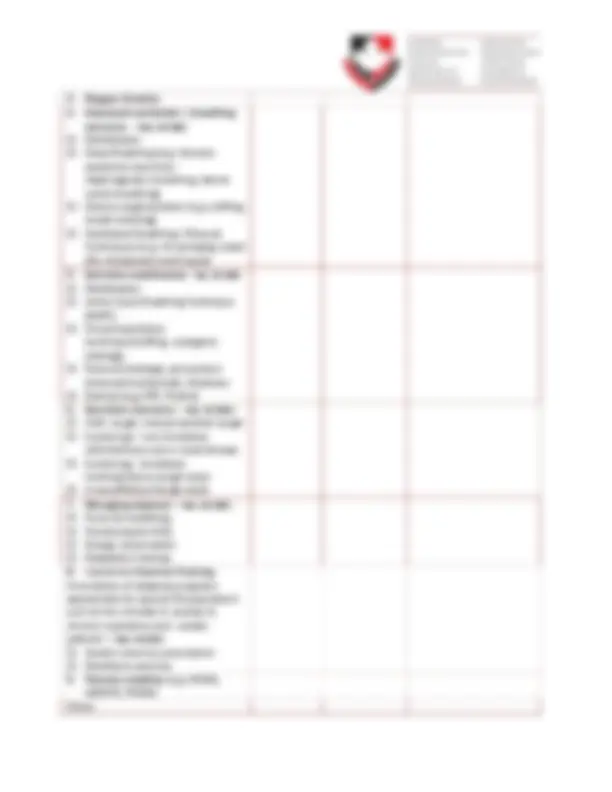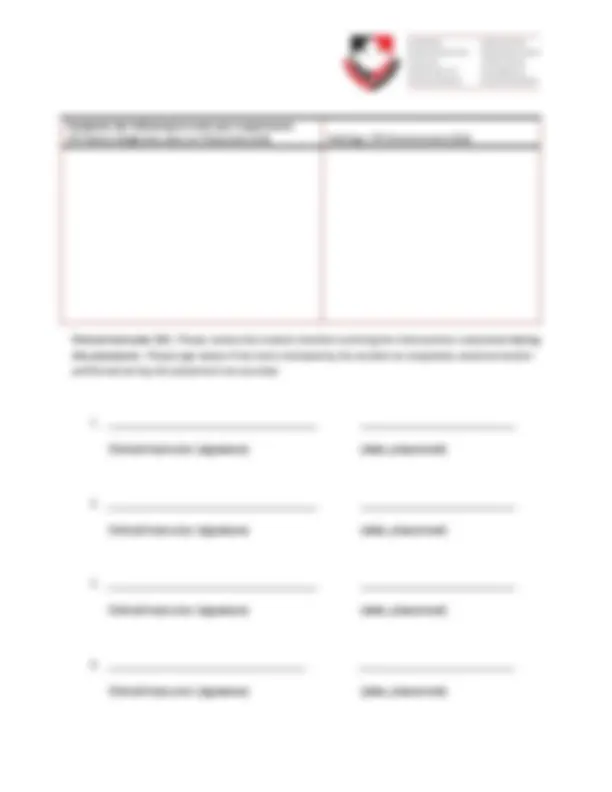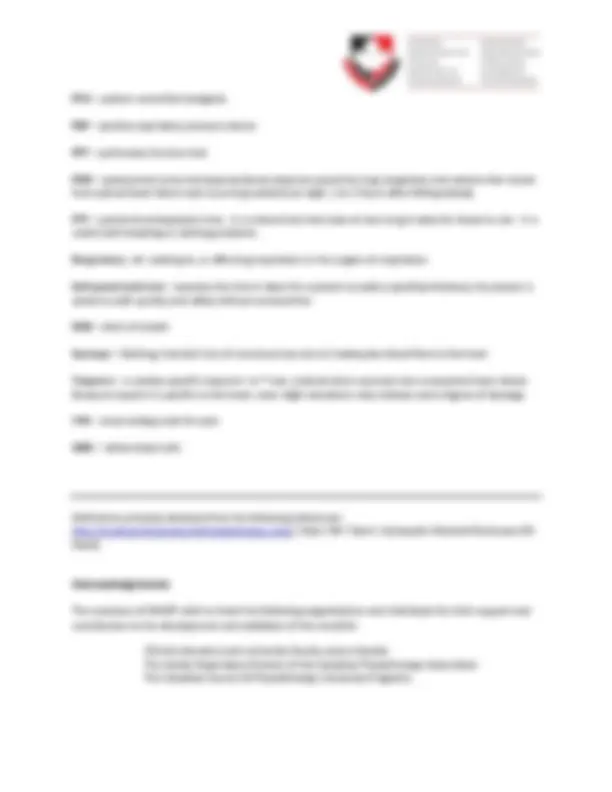Download Cardio-Respiratory Interventions Checklist for Entry-Level Physical Therapy Students and more Summaries Physiotherapy in PDF only on Docsity!
A Checklist of Key Cardio-Respiratory Interventions
for Entry-Level Physical Therapy Students
Introduction
Members of the National Association for Clinical Education in Physiotherapy (NACEP) identified
the need to develop a strategy to increase clinical placement capacity in a number of
geographical and practice areas. One approach which has received widespread endorsement is
the development of a checklist to track key interventions for specific practice areas. Clinical
research supports the assessment and treatment of the cardio-respiratory system by
physiotherapists as a part of the holistic treatment of most patients. It also provides evidence
for such assessments and treatments to be utilized in all practice areas, not simply those which
are known to treat CR indicator conditions (e.g. heart failure, chronic obstructive pulmonary
disease, diabetes). Recognizing opportunities to assess and promote the ability to perform
aerobic exercise and to identify its role in chronic disease prevention will provide the student
with repeated occasions to observe and participate in CR clinical experiences. All instances
where a student utilizes knowledge and skills related to cardio-respiratory conditions and
interventions should therefore be considered as relevant and appropriate cardio-respiratory
experiences.
Objectives
The objectives of the CR checklist are: (1) to ensure that physiotherapy students gain
experience with essential clinical skills, attitudes and behaviours within CR in order to obtain
the minimum entry-level cardio-respiratory competencies prior to graduation, (2) to provide
clinical supervisors with guidance as to the practice settings and clinical situations in which
competence may be assessed; and (3) to highlight for students, clinical instructors and facilities
that any clinical setting has the potential to assist students in acquiring CR competencies.
The checklist has been prepared in such a way as to make it manageable; it is not meant to be
an exhaustive list of possible interventions. In no way does it preclude students from obtaining
experiences above and beyond those which have been included. Furthermore, each university
program is encouraged to use and adapt the checklist in the manner in which it will be of most
use. For example, the checklist may be enhanced to include an evaluative component, or
modified to reflect provincial scopes of practice.
Development
The checklist was developed by a NACEP working group, following the collection of an inventory
of existing documents and checklists from across the country. A nationwide validation survey
was conducted, and included input from clinical educators who provide CR services, school of
physical therapy faculty, instructors and lecturers responsible for CR instruction within the
Masters-level physical therapy university programs, and representatives from centres of
coordinators of clinical education. The Cardio-Respiratory Division of the Canadian
Physiotherapy Association reviewed drafts of the document both before and after the
validation process was completed.
Consideration was given to two key documents during the development of the checklist. It is
recommended that the checklist be used in conjunction with the Essential Competency Profile
published by the National Physiotherapy Advisory Group in 2009 and the Entry-to-Practice
Physiotherapy Curriculum: Content Guidelines for Canadian University programs (May, 2009)
published by the Canadian Council of Physiotherapy University Programs. The first document
outlines the roles and specific competencies required of all practitioners, regardless of practice
setting. While the second document provides a list of activities through which the student may
demonstrate acquisition and integration of knowledge, skills, and behaviours, it is not written in
such a way as to provide measurable indicators.
Contents
Appendix A contains the checklist to be used by students to document CR experiences while in
the clinical setting. Students and clinical educators should note that the checklist contains
knowledge and elements of practice that are SPECIFIC to CR patients/clients; it does not include
interventions that are deemed to be essential with all physiotherapy patient populations (e.g.
patient education, assessing response to treatment, interprofessional collaboration etc.)
A list of abbreviations and key terms used in the checklist can be found in the glossary at the
end of the document. It is recommended that the checklist be reviewed in three years in order
to account for changes in practice and/or curriculum and any feedback received.
The checklist is based on the following inventory of knowledge and clinical activities:
A. Foundational Knowledge
The following are curriculum components which are deemed necessary for the preparation of
students, and comprise the knowledge upon which all clinical activities should be based.
h. Inspection – respiratory rate, rhythm, thoracic shape, hydration, clubbing,
breathing pattern, etc.
i. Palpation – position of trachea, expansion, flexibility, diaphragmatic excursion,
tactile fremitus, subcutaneous emphysema
j. Mediate percussion (percussion effected by the intervention of a finger between
the striking finger and the part percussed)
k. Auscultation
l. Cough, sputum
m. Investigations – CXR, lab results, PFTs, ECG interpretations, ABGs
n. Medications (such as key respiratory and cardiac medications – indications for
use and side effects)
o. Vital signs - e.g. heart rate, oxygen saturation, blood pressure, respiration rate,
temperature
Analysis of assessment findings and establishment of a physiotherapy diagnosis and
prognosis
Intervention
a. Exercise – best practice exercise prescription for a variety of populations,
modification of exercise and activity in the presence of pathology, implementing
movement interventions including exercise prescription, prescribing assistive
devices
b. Airway mobilization and airway clearance techniques – suctioning, PEP/Flutter,
postural drainage, percussion, huff, cough, assisted cough, active cycle
breathing, mechanical in-exsufflation, autogenic drainage, vibrations
c. Improving gas exchange and managing low lung volumes – summed breathing,
breath stacking/lung volume recruitment, therapeutic positioning, deep
diaphragmatic breathing, movement, glossopharyngeal breathing, respiratory
muscle training, oxygen titration, modes of ventilation - mechanical ventilation,
BiPAP
d. Managing dyspnea – relaxation training, therapeutic positioning, exercise,
pursed lip breathing, energy conservation, education
e. Safely manipulate tubes and lines during patient mobility – catheters, including
peripheral intravenous catheters, IVs, chest tubes, surgical drains, endotracheal
tube
Appendix A
Checklist of Minimum yet Essential Cardio-Respiratory Interventions for Entry-
Level Physical Therapy Students
N.B. Clinical research supports the assessment and treatment of the cardio-respiratory system
by physiotherapists as a part of the holistic treatment of most patients. It also provides
evidence for such assessments and treatments to be utilized in all practice areas, not simply
those which are known to treat CR indicator conditions (e.g. heart failure, chronic obstructive
pulmonary disease, diabetes). Recognizing opportunities to assess and promote the ability to
perform aerobic exercise and to identify its role in chronic disease prevention will provide the
student with repeated occasions to observe and participate in CR clinical experiences. All
instances where a student utilizes knowledge and skills related to cardio-respiratory conditions
and interventions should therefore be considered as relevant and appropriate cardio-respiratory
experiences.
IMPORTANT NOTICE TO STUDENTS
The checklist is a guide for tracking PT student CR experiences. The checklist should be used to guide/maximize a student’s CR clinical experience. A student is unlikely to obtain exposure and/or clinical experience in all of the areas listed prior to graduation. The checklist is NOT meant to be used as an evaluation tool or a measure of a student’s CR clinical competence.
Objective: Inspection/Observation: The student will demonstrate knowledge and/or use of a variety of objective assessment measures such as those listed below, in keeping with the practices of the clinical setting. Completed (√) Comments
- Lines and Tubes (understand implications)
2. Understand the implications of and Perform Vital
Signs (e.g. heart rate, oxygen saturation, blood pressure, respiration rate, temperature)
3. Fluid Balance (understand implications)
4. Jugular venous pressure (distention), peripheries,
abdomen (understand implications) Observed/ Discussed (√)
Performed on Patient (√)
Comments
1. Chest Assessment (IPPA)
I nspection (cyanosis, clubbing; rate, rhythm, depth; indrawing, accessory muscle use)
P alpation (e.g. position of the trachea, diaphragmatic excursion, sites of chest pain/tenderness) P ercussion (resonant, hyperresonant, dull) A uscultation (e.g. vocal sound, breath sounds, adventitia)
Cough (effective, ineffective)
Sputum (colour, consistency)
2. Mobilization (independent; with supervision/assistance) Bed mobility
Transfers
Gait/Ambulatory status (with/without mobility aid; with supervision/assistance)
3. Functional Capacity Measures ( MWT, self-paced walk, shuttle walk) 4. Balance (sitting, standing, walking) 5. Posture (affecting chest expansion) 6. Strength/Endurance (sufficient for safe mobilization) 7. Range of Motion (e.g. UE/thoracic
ROM for thoracic/cardiac/abdominal surgery and COPD Other:
Analysis and Planning
The student will learn to collect and analyze assessment findings and apply these to the identification of goals and the development of treatment plans, in keeping with the practices of the clinical setting.
Completed (√) Comments
1. Formulate and articulate evaluation findings 2. Establish short- and long-term patient-centered goals 3. Develop effective treatment plans
Treatment Techniques
The student will become knowledgeable about a number of treatment methods, but may only practice some. All students should endeavour to obtain practice with a variety of treatment techniques, in keeping with the practices of the clinical setting.
Observed/ Discussed (√)
Performed on Patient (√)
Comments
1. Mobilization (e.g. bed mobility; transfers from bed to std., chair; walking within a room; stairs; prescription of mobility device) 2. Safe management of tubes and lines (including peripheral intravenous catheters, IVs, Foley, chest tubes, surgical drains, endotracheal tube)
Complete the following to track your experiences: CR Patient Diagnoses seen on Placement (list) Settings / CR Environments (list)
Clinical Instructor (CI) : Please review the student checklist outlining the interventions completed during this placement****. Please sign below if the items indicated by the student as completed, observed and/or performed during this placement are accurate.
1. ___________________________________ __________________________
Clinical Instructor (signature) (date, placement)
2. ___________________________________ __________________________
Clinical Instructor (signature) (date, placement)
3. ___________________________________ __________________________
Clinical Instructor (signature) (date, placement)
4. _________________________________ __________________________
Clinical Instructor (signature) (date, placement)
GLOSSARY OF TERMS / LIST OF ABBREVIATIONS
2MW / 6MW Test – 2 and 6 minute walk tests
AAROM – active assisted range of motion
ABG – arterial blood gases
Accessory muscle use - typically only used when the body needs to process energy quickly (e.g. during strenuous exercise, or during an asthma attack). When a breathing pattern disorder exists (e.g. COPD) accessory muscle use may be used as their regular breathing pattern.
Adventitia – adventitious breath sounds; abnormal breath sounds
Angina – chest pain that occurs when the heart muscle is not getting enough oxygen-rich blood
ARDS – acute respiratory distress syndrome
AROM – active range of motion
Breath Stacking - A special chest technique used in patients who are unable to fully inflate their lungs
due to weakness or paralysis of the respiratory muscles. The equipment consists of an ambu bag fitted
with a one-way valve, a mouthpiece and nose clip. The one-way valve is used to help build up volume in the patients lungs by allowing air to get in but not out. This technique is used to help prevent lung and chest wall stiffness and to keep lungs clear of secretions.
BUN – blood urea nitrogen test
Cardiorespiratory physiotherapy (or physical therapy) Cardiorespiratory physiotherapy (or physical therapy) is a component of primary health care which focuses on maximizing functional independence and well-being, when these are threatened by problems in oxygen transport, using primarily noninvasive interventions including exercise and mobilization, body positioning, breathing control and coughing maneuvers, relaxation and energy conservation, and airway clearance interventions. It applies a patient-centered model of care incorporating multisystem assessment, evidence-based interventions and a significant education component to promote healthy active lifestyles and community based living^1.
Cardiovascular - r elating to the circulatory system, which comprises both the heart and the blood vessels and their functions.
CLASP – Coalitions Linking Action and Science for Prevention
(^1) The Gas Exchange, Oct 1998; 8(3):5.
PCA – patient controlled analgesia
PEP – positive expiratory pressure device
PFT – pulmonary function test
PND – paroxysmal nocturnal dyspnea (acute dyspnea caused by lung congestion and edema that results from partial heart failure and occurring suddenly at night, 1 to 2 hours after falling asleep)
PTT – partial thromboplastin time. It is a blood test that looks at how long it takes for blood to clot. It is useful with bleeding or clotting problems.
Respiratory - o f, relating to, or affecting respiration or the organs of respiration.
Self-paced walk test – assesses the time it takes for a person to walk a specified distance; the person is asked to walk quickly and safely without overexertion
SOB – short of breath
Syncope – fainting; transient loss of consciousness due to inadequate blood flow to the brain
Troponin – a cardiac-specific troponin I or T test, ordered when a person has a suspected heart attack. Because troponin is specific to the heart, even slight elevations may indicate some degree of damage.
VAS - visual analog scale for pain
WBC – white blood cells
Definitions primarily obtained from the following references http://medical-dictionary.thefreedictionary.com/; Taber CW: Taber’s Cyclopedic Medical Dictionary (FA Davis)
Acknowledgements
The members of NACEP wish to thank the following organizations and individuals for their support and
contribution to the development and validation of the checklist:
Clinical educators and university faculty across Canada The Cardio-Respiratory Division of the Canadian Physiotherapy Association The Canadian Council of Physiotherapy University Programs

